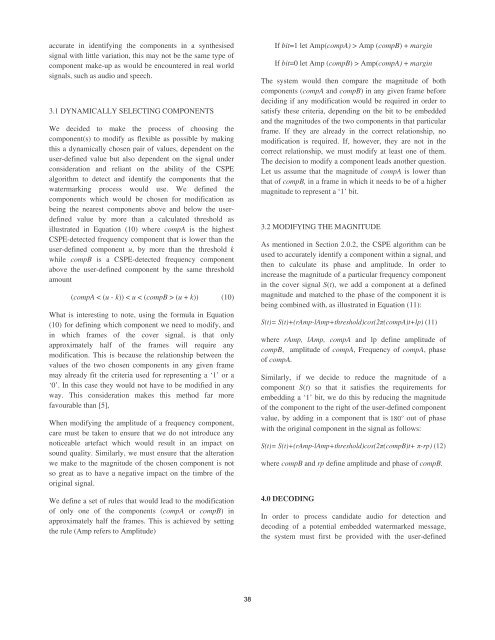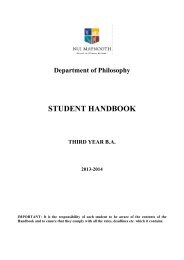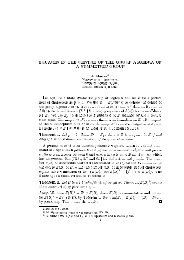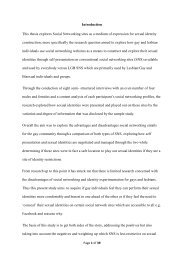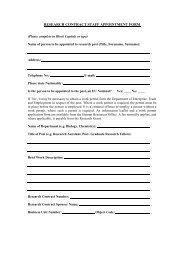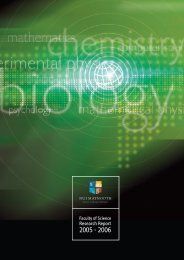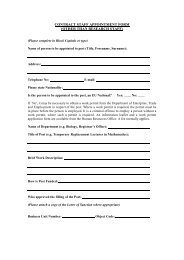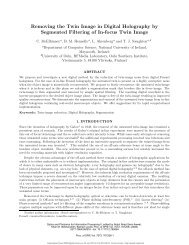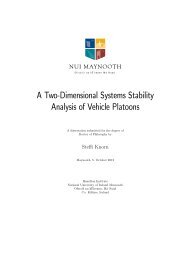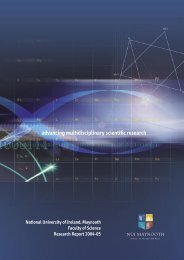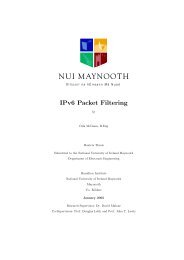CIICT 2009 Proceedings
CIICT 2009 Proceedings
CIICT 2009 Proceedings
- No tags were found...
Create successful ePaper yourself
Turn your PDF publications into a flip-book with our unique Google optimized e-Paper software.
accurate in identifying the components in a synthesisedsignal with little variation, this may not be the same type ofcomponent make-up as would be encountered in real worldsignals, such as audio and speech.3.1 DYNAMICALLY SELECTING COMPONENTSWe decided to make the process of choosing thecomponent(s) to modify as flexible as possible by makingthis a dynamically chosen pair of values, dependent on theuser-defined value but also dependent on the signal underconsideration and reliant on the ability of the CSPEalgorithm to detect and identify the components that thewatermarking process would use. We defined thecomponents which would be chosen for modification asbeing the nearest components above and below the userdefinedvalue by more than a calculated threshold asillustrated in Equation (10) where compA is the highestCSPE-detected frequency component that is lower than theuser-defined component u, by more than the threshold kwhile compB is a CSPE-detected frequency componentabove the user-defined component by the same thresholdamount(compA < (u - k)) < u < (compB > (u + k)) (10)What is interesting to note, using the formula in Equation(10) for defining which component we need to modify, andin which frames of the cover signal, is that onlyapproximately half of the frames will require anymodification. This is because the relationship between thevalues of the two chosen components in any given framemay already fit the criteria used for representing a ‘1’ or a‘0’. In this case they would not have to be modified in anyway. This consideration makes this method far morefavourable than [5],When modifying the amplitude of a frequency component,care must be taken to ensure that we do not introduce anynoticeable artefact which would result in an impact onsound quality. Similarly, we must ensure that the alterationwe make to the magnitude of the chosen component is notso great as to have a negative impact on the timbre of theoriginal signal.We define a set of rules that would lead to the modificationof only one of the components (compA or compB) inapproximately half the frames. This is achieved by settingthe rule (Amp refers to Amplitude)If bit=1 let Amp(compA) > Amp (compB) + marginIf bit=0 let Amp (compB) > Amp(compA) + marginThe system would then compare the magnitude of bothcomponents (compA and compB) in any given frame beforedeciding if any modification would be required in order tosatisfy these criteria, depending on the bit to be embeddedand the magnitudes of the two components in that particularframe. If they are already in the correct relationship, nomodification is required. If, however, they are not in thecorrect relationship, we must modify at least one of them.The decision to modify a component leads another question.Let us assume that the magnitude of compA is lower thanthat of compB, in a frame in which it needs to be of a highermagnitude to represent a ‘1’ bit.3.2 MODIFYING THE MAGNITUDEAs mentioned in Section 2.0.2, the CSPE algorithm can beused to accurately identify a component within a signal, andthen to calculate its phase and amplitude. In order toincrease the magnitude of a particular frequency componentin the cover signal S(t), we add a component at a definedmagnitude and matched to the phase of the component it isbeing combined with, as illustrated in Equation (11):S(t)= S(t)+(rAmp-lAmp+threshold)cos(2(compA)t+lp) (11)where rAmp, lAmp, compA and lp define amplitude ofcompB, amplitude of compA, Frequency of compA, phaseof compA.Similarly, if we decide to reduce the magnitude of acomponent S(t) so that it satisfies the requirements forembedding a ‘1’ bit, we do this by reducing the magnitudeof the component to the right of the user-defined componentovalue, by adding in a component that is 180 out of phasewith the original component in the signal as follows:S(t)= S(t)+(rAmp-lAmp+threshold)cos(2(compB)t+ -rp) (12)where compB and rp define amplitude and phase of compB.4.0 DECODINGIn order to process candidate audio for detection anddecoding of a potential embedded watermarked message,the system must first be provided with the user-defined38


